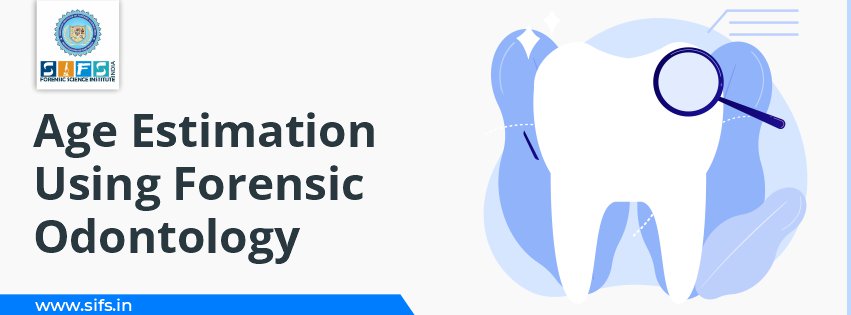- Call Us: +91 7303913002
- Email Us: education@sifs.in
Age Estimation Using Forensic Odontology

BY SIFS India | January 27, 2025
Age Estimation Using Forensic Odontology
Loss of identity for both living and deceased poses a frequent problem for individuals and authorities.
Reconstruction of the biological profile of an unknown individual would be incomplete without age determination.
Age estimation is the determination of an individual’s age based on their biometric features.
This is one of the important aspects of forensic anthropology. Age estimation from unknown skeletal remains is said to be the process of estimating the individual’s age at the time of death which can guide us through the investigation.
Methods of Age Estimation
Age estimation is very important as the age at the time of death can help us identify the birth date, year of death, and gender which can guide the investigators to figure out the correct identity among a large number of possible matches.
This can be achieved through various methods. The most commonly used age estimation methods that are being practised by forensic anthropologists are based on:
- Dental examination
- Study of pubic symphyses
- Study of cranial structure
- Study of the auricular surface of ilium
Age Estimation Based on Odontology
Dental age estimation (DAE) methods are based on changes in an individual’s dentition throughout their lives that comprise growth and development along with post-formation changes.
This was introduced by Edwin Saunders in the year 1837 when he gave a comprehensive approach to dental age estimation for adults.
This method was later developed by many upcoming scientists and now with the help of their discoveries and modern technology, age estimation based on dentition is very accurate and a pretty quick process.
Ways to Determine Age based on Dentition
On the basis of dentition obtained from the skeletal remains age of the unknown or known individual can be concluded using one or more ways. Dental development is usually less affected by malnutrition and hormonal disorders thus being preferred to determine age. Ways of determining age based on dentition are:
- Clinical method
- Radiological method
- Radioactive method
- Histological method
Clinical Method
The developing dentition can be used to gain knowledge on maturity and thus can help in estimating the age of the individuals. The clinical method for determining age is based on the emergence of teeth in the mouth.
As this method does not require any special equipment or expertise and since it is more economical this is more widely accepted and suited.
The time of eruption of teeth is fairly constant among all individuals thus it can be used to ascertain the average age of eruption of the tooth.
Understanding the growth of deciduous teeth and changes from deciduous to permanent teeth and the development of permanent teeth helps us estimate the age of an individual.


Figure 1 - Eruption of Primary and Permanent Dentition
Radiological Method
Since 1982 , dental radiography which is a non-destructive and simple technique is used in dental practice as a method of age estimation.
Based on the assessment of the extent of calcification of teeth and in turn, the degree of formation of the teeth crown and root structure along with sequence and stage of eruption gives us an estimated age, gender and ethnic group. Identifying the stage of mineralization on radiographic images is compared with a standard stage to estimate the approximate age.


Figure 2 - Development of Teeth of an Individual
Radioactive Method
In recent years, forensic anthropologists inspired by the carbon dating methods of archaeologists found a way to estimate the age of skeletal remains using the same carbon dating method.
Radiocarbon or Carbon 14 is produced naturally in the atmosphere and its concentration has doubled since the 1960s during usage of nuclear weapons. To figure out the year of birth, researchers used the teeth' enamel.
The researchers found that if they assumed tooth enamel radiocarbon content to be determined by the atmospheric level at the time the tooth was formed, then they could deduce the year of birth.
To estimate an individual’s date of birth:
- 14C concentration measured in the tooth enamel is plotted on to a curve of atmospheric 14C against time to determine the year of enamel synthesis and
- The time (in years) taken for the enamel to form is subtracted from the year obtained. This gives an estimated date of birth.

Figure 3 - Age Estimation Graphical Representation
Histological Method
In the histological method, the dental tissue is prepared for detailed microscopic examination. This method is mostly used for postmortem situations.
The histological methods can detect mineralization before being detected in the radiographs. For an infant neonatal lines are used to give the age of the baby in days.
Observing the neonatal lines can be used for accessing the amount of pre and post-natal enamel formation.
The neonatal lines, present in both enamel and dentin of the permanent teeth, are an optical phenomenon produced due to alteration in the dimension, degree and mineralization of enamel prisms caused due to the sudden change from intrauterine to the extrauterine environment.
Consideration for Odontology Age Estimation
- Gender differences may exist. The dentition of males shows better development than women but maturity is higher in women. For this, dental age estimations methods publish sex-specific charts to increase the accuracy of age determination. In the absence of knowledge of sex, age can be estimated roughly or for accurate estimation pulp to tooth ratio is calculated.
- There may be a significant delay in dental age in the subjects with dental agenesis.
- Orthodontic treatments cause external root resorption causing a potential risk of overestimating the age of the individual. In such a situation, various methods must be adopted to avoid this issue.
Conclusion
In terms of legal representation, age estimation is one of the most crucial steps for identification in forensic odontology either in the case of a deceased or living person. Determination of age based on dentition is done with reference to the ever-growing human deciduous and permanent dentitions.
Dental age estimation is widely accepted as it is highly accurate and the maximum amount of error is between six months to one year. The researchers are now confronted with the development of new population-specific standards using recent advancements for age estimation.
Note - The figures and images used in this blog are only for educational purposes.
Written by: Ar. Versha

